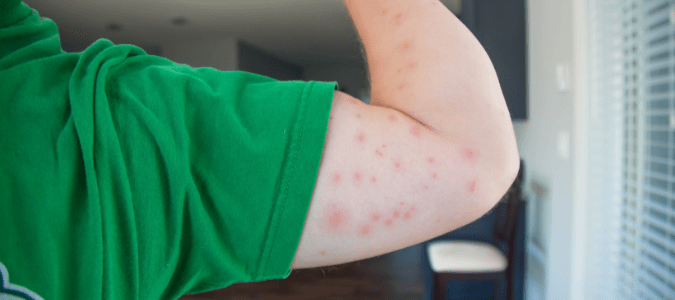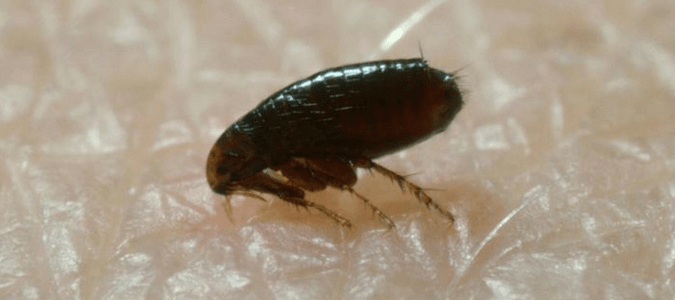Fleas can cause lots of problems for both humans and animals. It’s no fun to deal with red, itchy bites on your own skin, and it’s no better to see your beloved pet scratching and suffering. Sometimes it’s hard to know whether you’re dealing with fleas or some other pest. What do flea bites look like? How can you tell if you have a problem with fleas, mosquitoes, bed bugs or something else? Here are some ways to tell what you’re dealing with, so you can get rid of them as soon as possible.
Flea bites look like small red dots on the skin, about a quarter-inch in diameter. There might be a tiny bump in the center of the bite, or it might be flat. Depending on your body’s reaction to the bites, they could also develop into larger, raised welts. Whatever size they are, flea bites are usually itchy.
Flea bites are usually randomly scattered across the skin, but they are most likely to be located on your feet and ankles. These tiny insects have powerful legs that make them incredible jumpers for their size, but they can’t jump much higher than your mid-calf. If you have a flea problem in your home or yard, you’ll probably receive most of your bites on your feet, ankles and lower legs.
Keep in mind that fleas are most active during the warmer months of the year. This is similar to mosquitoes, but mosquitoes most often bite people outdoors. Fleas can bite outdoors or indoors, and flea infestations are more common inside. Bed bugs can be active throughout the year, and only indoors. Their bites are intensely itchy and are often clustered together in lines, whereas flea and mosquito bites are more randomly distributed.
These are some of the ways to tell flea bites apart from other types of insect bites. Another way is to take a look at your pets. On dogs, flea bites can look a little different than they do on people. They might show up as individual red dots, but they also might cause more widespread redness, flaking and inflammation on the skin. This can be seen especially on the dog’s stomach or at the inner tops of the back legs.
Their itchy bites are just one sign of fleas. There are several other signs that can tip you off to a flea infestation in your home or yard. In dogs and cats, the most noticeable sign of fleas is often their scratching. Animals with flea problems might scratch almost compulsively. In fact, they can develop anxiety and obsessive-compulsive behavior as a result of an ongoing flea infestation.
You might see fleas themselves, either on your pet or on your own skin. Fleas are tiny, wingless, and dark brown or black in color. They are about the size and color of a speck of black pepper. They can move around by walking or crawling, and they can also jump several inches into the air. You might spot one on your skin, only to lose sight of it a second later when it leaps away.
Fleas are hard to catch because they’re so tiny and they move so fast. They are especially good at hiding in animal fur. You might spot one in your dog’s fur, but as soon as you try to pick it up, it disappears between the individual hairs. Even if you do manage to grab it, you may find that it escapes easily. Fleas have flat bodies that are hard to squish, even between your fingernails.
Another sign of fleas is small, reddish-black specks of what looks like dirt on your pet’s skin. This is called flea dirt, but it’s actually feces—bits of old, partially digested blood that adult fleas excrete. Flea dirt can also be found in the affected animal’s bedding or anyplace where the animal spends lots of time. If your pet sleeps on your sofa or your bed, for example, you may find flea dirt in these areas. You’ll also probably find live, active fleas.
Fleas reproduce very quickly. A flea infestation can grow out of control in just a short period of time. Fleas can also transmit illnesses through their bites. For all of these reasons, a flea problem needs to be addressed as soon as possible to get it under control. Hiring a pest control professional is often the best, most efficient way to get rid of fleas.
If you have pets, it’s also wise to reach out to your veterinarian for ways to treat your animals. Adult fleas live in an animal’s fur, but their eggs can fall off the animal and survive in bedding, on furniture or even between the floorboards until they hatch. For this reason, the home and animal need to be treated at the same time to eliminate the flea problem.
Your yard may also need to be treated simultaneously for fleas. Fleas can live and feed on wild animals outdoors, such as squirrels, birds and rodents. In areas with lots of animal life outside, flea infestations in yards are common. In fact, that’s often how fleas move indoors—when people’s pets bring them in from outside. A pest control professional will inspect your home and yard so they can tailor a multi-point approach to getting rid of your pest infestation, as quickly and thoroughly as possible.
What Do Dog Fleas Look Like?
There are various species of fleas that can infest a home—over 300 species in the United States alone. Though fleas are most commonly associated with dogs, cat fleas are actually the type most likely to infest people’s homes. Still, dog fleas do sometimes infest the home as well. Both cat fleas and dog fleas can bite people, dogs, cats and other animals. So what do dog fleas look like?
The truth is, you would need a microscope to see the differences between dog fleas and cat fleas. If you have a flea problem, you probably won’t be able to tell which type of flea it is. In general, fleas look like a very small, dark speck. Unless your eyesight is really good, they look like a speck of pepper on your skin—pepper that moves quickly, that is.
Fleas don’t have wings, but they do jump on powerful back legs. They can jump several inches into the air. You might feel a tiny tickle on your foot, ankle or lower leg, or even the tiny pinch of a bite. If you look down, you might see the little black dot that is the flea that’s tormenting you.
Fleas can also be spotted in an animal’s fur, but they move quickly between the hairs and are very good at hiding. If you look very closely, you might also see tiny, whitish dots in your pet’s fur, or else in its bedding. These are flea eggs. The eggs are smooth and fall right out of an animal’s fur. Wherever they fall, they can survive until they hatch into tiny flea larvae, as long as they aren’t vacuumed up or washed away.
Since animals with fleas introduce these pests into the home, it’s important to treat the animal’s bedding for fleas along with any places where it spends lots of time. If your dog has a favorite spot on the rug or the couch, that spot may be full of flea eggs or larvae that are tough to see with the naked eye.
Contacting a pest control professional is the best way to deal with a flea infestation. A pro knows where to look for fleas in all stages of the life cycle, and how to eliminate them.
Fleas on Couch: What to Do
If you find fleas on the couch, don’t panic. This is a common problem in homes with pets. Animals like cats, dogs, and even rabbits or ferrets can harbor fleas. If your pet has fleas and likes to spend time on the couch, it’s only a matter of time before you’ll be dealing with fleas on the couch.
Fleas become a problem on our furniture in part because they reproduce so quickly. Female fleas can lay 40 to 50 eggs a day! Adult fleas live right on animals’ bodies, hidden in their fur, and that’s where they lay their eggs. But the eggs typically fall off the animal’s body and, after a number of days, hatch wherever they landed.
For this reason, getting rid of fleas is a process that requires multiple steps, products and techniques. You can’t just treat your dog for fleas, for example. You also need to treat his bedding and the sunny spot on the couch where he likes to nap. Not only that, but the flooring below the couch will also need to be cleaned carefully, because of the flea eggs that have no doubt fallen down there.
If you have fleas on your couch, or you have spotted flea dirt or other evidence of these pests, you’ll need to get rid of them by washing your couch cushion covers in hot water. If your couch doesn’t have removable covers, you’ll need to remove all the cushions and vacuum them thoroughly.
Be sure to pay attention to all the nooks and crannies of the couch. Run the vacuum wand into the deep recesses to catch as many potential flea eggs and larvae as possible. Vacuum the floor around the couch as well. These techniques also help to get rid of fleas on your mattress. It’s also a good idea to use a hot steam mop, if you have one and have the type of flooring that can withstand the moist heat.
Remember that getting rid of fleas is a process that takes time. It requires a whole-home approach, not just treating one single area. Your veterinarian can help you treat your pets as your trusted pest control specialist treats your entire home and yard.
After that, keeping up with regular vacuuming and washing of your own bedding and your pet’s will help to kill off these pests’ eggs and larvae. Together, these techniques should keep fleas away from your home and your beloved animal companions.
ABC Can Control the Fleas on Your Property
Dealing with a flea problem can be time-consuming and frustrating. Instead of trying to get rid of these pests on your own, contact ABC Home & Commercial Services. Our licensed professionals will create a comprehensive flea control plan, so you and your family members don’t have to worry about any more itchy bites.



